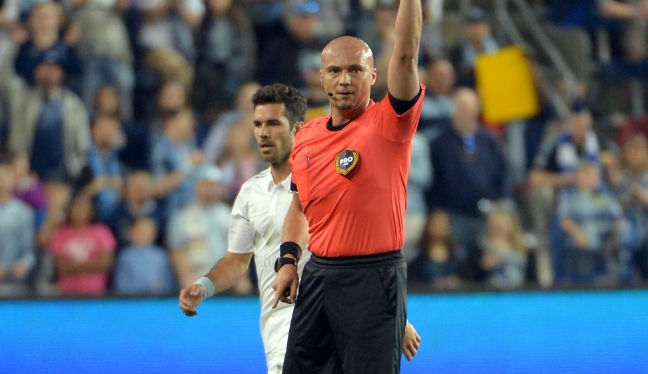Play of the Week 1: Decisive decision making
By PRO Training & Development Manager Paul Rejer
There are many aspects to referees’ decision making and, obviously, making the correct decision is the most important.
How the referee ‘sells’ the decision is also very important. Any kind of indecision or hesitancy on the referee’s part can expose them to allowing players, coaches and fans to consider that they have doubts in the validity of their decision. This in itself can encourage dissent and challenges to the referee.
On the opening weekend of the 2017 MLS season, we had three examples of referee decision making where it could be argued that all three decisions were correct, but the referee’s body language is initially unconvincing and openly displays that there may be doubts in his mind.
In the first example, from Portland Timbers versus Minnesota United, as the ball is crossed into the Minnesota penalty area, Timbers’ Fanendo Adi goes to ground under the weight of United’s Vadim Demidov.
Looking at referee Chris Penso, he initially puts his whistle to his mouth and he immediately considers that this is a foul. However, doubts come into his mind and he allows play to continue.
Holding in the penalty area is a point of emphasis for this season and it probably influenced Penso in his initial thoughts. However, ultimately, he was unsure whether it was a genuine foul and how much contact forced Adi to go to ground. While a PK would certainly have been supported due to the initiative, referees still have to be 100 per cent sure before awarding a PK, point of emphasis or not.
In the second example, from Columbus Crew versus Chicago Fire, when Crew’s Nicolai Naess controls the ball, it deflects and hits his arm. At this point, referee Fotis Bazakos, like Penso in the previous example, initially puts his whistle to his mouth then immediately changes his mind and gestures firmly with his arms, “no handball”.
Crew keep possession and score the opening goal of the game. This causes a number of Fire players to question the initial no handball call – which you cannot see on this clip – even though it was 20 seconds earlier. This reaction from the players was caused by the perceived handball but intensified by the referee’s body language in putting whistle to mouth, which actually caused players to stop.
Was this deliberate handball? In my opinion, no. Therefore, the referee has to be supported in his decision. Was handball the expected decision? Yes. So consider the consequences between a simple foul on the half-way line that few would have disputed, against a disputed goal.
In the third example, from D.C. United versus Sporting Kansas City, when D.C.’s Jared Jeffrey is fouled by SKC’s goalkeeper Tim Melia deep inside his penalty area, referee Robert Sibiga initially does not award the PK but follows play.
He then belatedly, and correctly, makes the right call by awarding the penalty. We know that referees tend to play incidents through in their minds plus, no doubt, receive help from their colleagues. The referee’s body language, by initially following play, suggested that he had doubts about the validity of the penalty even though the eventual award was correct.
The common theme with all three decisions is the initial hesitancy of the award, but it is better to have a hesitant correct decision than an incorrect decisive one! A firm, positive, decisive award given with confidence helps ‘sell’ the decision and is accepted more readily.
Referees should refrain from putting their whistle to mouth unless they intend to blow it. Players, coaches and fans will exploit any form of indecision or hesitancy.

